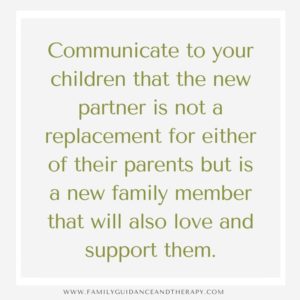Effective and open communication is foundational to the success of your blended family.
You and your partner have a lot to talk about as you incorporate several different family dynamics into your lives: remarriage, step-parenting, co-parenting, and new parenting.
You can create healthy relationships in all the varied forms that families exist, but it starts with you—the parents.
Your partnership is the hub that sets the standard for open communication and boundary settings that not only maintain the quality of your relationship but ensure all family members are valued and treated with respect.
Parental Partnership Sets the Foundation
It can be a challenging adjustment when you bring children that have existing adult-child relationships into a new family compared to relationships that start with a couple that has no children.
This family setting makes it so much more important for the adults in the family to agree to basic standards of communication. Start with these steps:
Agree to talk. Agree to talk openly, and about everything, and talk privately with each other as often as possible. Remember that listening is essential to good communication.
Share emotions. Agree to support your partner through shared emotions. Bottled up emotions are a hindrance to open communication. Encourage your partner’s ability and freedom to speak by agreeing to treat each other with uncompromising respect.
Commit to privacy. Schedule time away from the children for you and your partner to communicate and bond. Agree to meet privately when issues or disagreements arise. Prevent anxious thoughts in your children by communicating to them that your private meeting time with your partner is nothing to fear and is not personally about them.
Discuss and set parental styles. Prevent heated and emotional eruptions in your partnership and boost the bonding relationship of your family by agreeing to specific joint parental styles. Discuss how you will handle the children’s discipline, privileges, and daily expectations in the home. Discuss your partner’s unique roles that you will play within the family. Agree to communicate with each other, and not through any of your children. Agree to show respect for one another when your children are present.
Communication with both biological parents. Communication with a prior partner (your child’s parent) may be difficult at best. Children adjust to living in a blended family much better when they know they have access to both biological parents. Work out a level of communication with your “ex” that deters negative emotions.
If civil verbal words are not possible, consider texting or emailing as a style of communication. When your prior and current partners are on the same page, your children are much happier and are less anxious.
Let your children know that both you and their other parent will love and support them throughout their lives.
Communicate to your children that the new partner is not a replacement for either of their parents but is a new family member that will also love and support them.
Value and Respect Every Family Member
Your compassion is essential in helping your child settle into your blended family. It is important to understand that your child will adjust to the merging of a new family in their own unique way. Children adapt on different levels depending upon differences in development, age, and sex.
Children under 10 years of age may adapt to a blended family more easily because they flourish on secure family relationships.
Pre-teens may have more difficulty adjusting to the new family unit and may not be able to communicate that they need more time to adjust.
Older teenage children are typically involved with forming their own identifies and may not want to actively participate in family life. Teenage children may seem indifferent to affection, but they, like all children, have an ingrained need to feel secure, important, and loved.
Children of all sexes tend to favor verbal affection over physical closeness from blended family parents. Girls are often uncomfortable with physical displays of affection from a stepfather but are not comfortable with communicating their feelings. Boys tend to warm up to a stepfather more quickly than girls.
Everyone is valued. Encourage your children to know that every voice in the home is important. This is not dependent upon age or parental status.
Respectful communication and acknowledgment builds trust. When your child or partner converses, you and other family members must respond with courtesy, compassion, and honor any differences to bolster open communication and to nourish family growth.
Teach your children that listening, even if they hold a different perspective, is a vital element of communication within the family and in life itself.
Teach your children that empathy and healthy compromise is essential—meeting the needs of another person is more important than being right or getting your own way.
Set Boundaries
The setting of limits with children helps them to feel a sense of security. Firmness is not the same as dictating. Firmness can wipe out any sense of doubt and can promote a sense of “I belong, and I have a place in this family.”
When children understand their boundary line, that they are the child and that you are the parent, the decision-maker, and they see that their needs are important and met, they realize that no judgment will be placed on their emotions or fundamental needs to be heard and understood, which essentially promotes open communication.
Spend Time with Your Children
Spend time every day with your child. This can simply be a quiet time, or if your child wants to talk, then give them the gift of open communication. Listen to what they have to say. This helps the child to feel important as an individual even amid adjustment to a blended family.
Help your family bond and communicate by incorporating new family rituals into the week. You can make Friday nights a family celebration or pizza time, or Sunday afternoons can be spent at the park. Family get-togethers do not have to be filled with forced communication to be effective—simply allow fun and laughter to flow.
Seek Help
Despite all your good intentions and efforts, sometimes blended families experience serious problems that block effective communication and prevent family members from getting along.
Your children may show anger towards one or more family members or one parent.
A step-parent may not understand, feel empathy for, or get along with one or more children.
Together time may become negative fretful situations that may lead family members into anxiety rather than open communication or family outings that help the family to bond.
Your difficult circumstances may be unique but may also reflect one or some of these situations. Either way, you are not alone with this. We can help.
At the Family Guidance & Therapy Center, we serve the whole family with therapy designed to help you get the most out of your relationships.
There is no way to quantify your love for your loved ones. We are here for you so that your family stays strong. We are supportive of your values and determined to help each member of your family grow.
There are three easy ways to make an appointment with us, online, call 619-600-0683, or text 619-607-1230.

